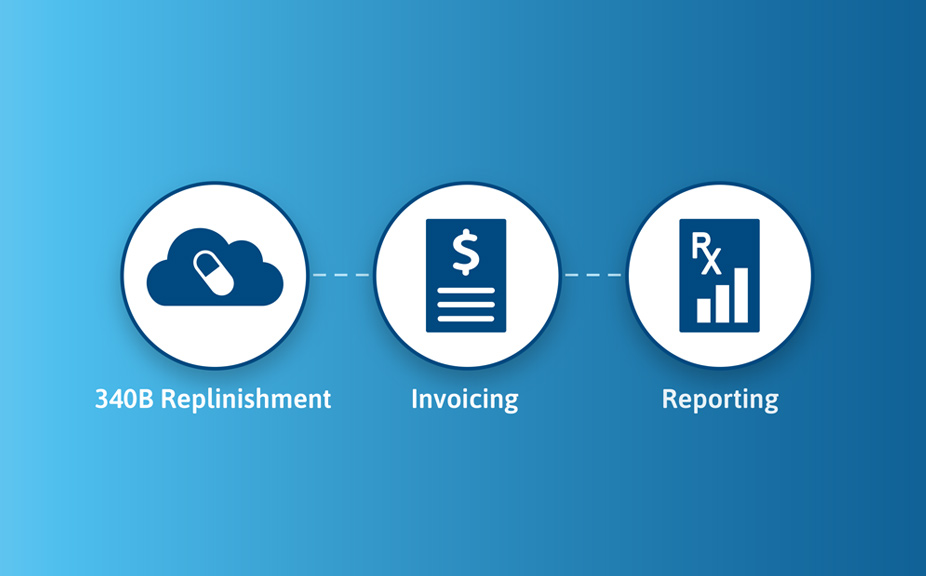How does it work?
A gateway works in traditional 340B fashion, working with the 340B Third-Party Administrators, Contract Pharmacies, Covered Entities, and Wholesalers. The gateway is set-up to receive claims related data on a daily data file from multiple sources; these are files that contain Pharmacy prescription data, Covered Entity claims data, and supply chain / replenishment data. After these files are ingested, some gates scrub the files against preset Pharmacy parameters. To confirm eligibility, these parameters consist of Pharmacy NPI files, NDC exclusions, BIN blocks, duplicate claims, etc. After eligibility validation is successful, and a full package size has been met, a file is sent to the appropriate wholesaler to begin the replenishment process as NDCs are purchased and shipped to the contracted pharmacy location. After a successful replenishment, 340B eligible NDC’s are prepared for invoicing to the CE.
Why should Pharmacies consider using a gateway?
When Pharmacies work with multiple 340B Third Party Administrators, with it comes multiple system logins, understanding the operations of each system, how each system operates differently, and limitations that come with each. No two 340B TPA systems are the same, each vary with availability of data, TPA workflows, reporting, etc. With a gateway solution, those operational processes, account logins, and other complications are limited, and the work related to 340B relationships become more efficient and manageable for the Pharmacy Chain. The Pharmacy Chain logs into one system, with a clear understanding of the unified reports and data analysis. Many of these gateway relationships also include an additional support resource to assist the Pharmacy Chain to more effectively management their 340B business.
How can Covered Entities effectively negotiate with a Pharmacy using a gateway?
First, CEs need to understand that not all gateways are the same or have the same philosophy. While in most cases, it is usually best that Covered Entities work with their TPA’s, which maintain relationships with all gateways, there may be exceptions. Most TPA’s are in the best position to represent their Covered Entity client’s position in negotiating with gateways, which represent the Pharmacy Chains. There are exceptions as some TPAs don’t provide pharmacy support when contracting with pharmacies. As with any business, there is a cost to doing business. As pharmacies attempt to improve the efficiencies associated with their 340B book of business, their operating cost increase. In almost every scenario, this results in increased costs. If a CE’s 340B program represents a significant percentage of the contracted pharmacies 340B prescription claims, this may present an opportunity for negotiation. Any CE always has the right to reach out to the pharmacy directly to engage in a dialogue around their fees. This may be needed in some cases, but in any situation, the relationship between a CE and their contracted pharmacy is critical to the success of all parties, including their patients and community.
For any 340B program to deliver the appropriate value for which it was intended, all parties should work together and build a strong partnership. Understand that the pharmacy is trying to keep up with the demand on their business and derive value by utilizing a gateway. In many cases, the additional gateway fees are transparent, but some may not be. Some pharmacy chains simply increase their dispensing fees to account for the increased operational costs of the gateway. These gateways do improve the operational efficiencies of the 340B workflow and overall value to all parties and should be accepted as part of doing business.
Contact us for more information on 340B pharmacy gateways.for more information on 340B pharmacy gateways.
The content in this blog is for informational purposes only and is not intended to be used in place of regulatory guidance. The opinions and views expressed herein are those of the authors and do not necessarily reflect the official position or opinions of SUNRx or any regulatory authority. Furthermore, some content may contain copyrighted material, the use of which has not always been specifically authorized by the copyright owner, but which we believe constitutes a "fair use" of any such copyrighted material as provided for in Section 107 of the US Copyright Law. We are making the information herein available in our efforts to advance understanding of the 340B program and its offerings. These views are always subject to change, revision, and rethinking at any time and may not be held in perpetuity.



